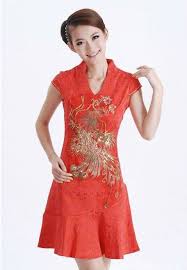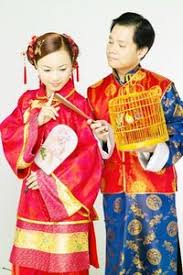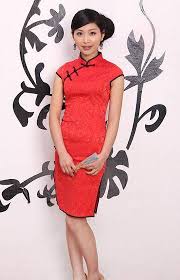source(google.com.pk)
Traditional Chinese Dresses Biography
Chinese people were wearing silk while other cultures were still dressing in animal skins.
Clothing in China did not only evolve over time; it often transformed dramatically following Dynastic changes or the Imperial decree of a new ruler. In ancient feudal society, people's rank and position could easily be distinguished from their daily dress, especially for the ordinary people and upper-class.
Among the upper dominating class, only to the Emperor was assigned the colour yellow and the dragon emblem on traditional Chinese imperial dress as an exclusive affirmation of their power.
There is no "typical" Chinese costume, although today, if any one style of clothing epitomises "Chineseness", it would be the Cheongsam, or Qipao, which evolved from ancient clothing of the Manchu ethnic minority. Popular because it fits the Chinese female figure well, has simple lines and looks elegant; it is suitable for wearing in all seasons by young or old and can either be long or short. It is recognised around the world and has inspired many foreign adaptations because of its simple yet exotic lines. It is popularly worn in northern China as the wedding dress, traditionally Red, embroidered with elaborate gold and silver designs. Brides in southern China wear Qipao or a two-piece dress name Qungua or Kwa, which is also elaborately adorned with a gold dragon and phoenix pattern.Hope you can come china and have your china holidays with top china travel.
China has many ethnic groups with a long history while Han people dominate most periods in history. For thousands of years, generations of clothing designers have devoted themselves to building the Kingdom of Clothes, making the garments that cover the human body into an important component of Chinese culture. The progress of nation can be seen through its changes in clothing styles.Clothing manufacture in China dates back to prehistoric times, at least 7,000 years ago. Archaeological findings
Because of relatively plain design and structure of traditional Chinese clothing, embroidered edgings, decorated bands, draped cloth or silks, patterns on the shoulders, and sashes were often added as ornamentation. These varied designs came to be one of the unique features of traditional Chinese dress.
Darker Colors
Darker colors were much more favored than lighter ones in traditional Chinese clothing so the main color of ceremonial clothing tended to be dark while bright, elaborate tapestry designs accented. Lighter colored clothing was worn more frequently by the common people for everyday use.
Colors and Seasons
The Chinese associate certain colors with specific seasons: green represents spring, red symbolizes summer, white represents autumn, and black symbolizes winter. The Chinese are said to have a fully developed system of matching, coordinating, and contrasting colors and shades of light and dark in apparel.
Red Color
Red is favorite for most Chinese people since Red symbolizes good luck in traditional mind. Chinese people prefer to wear in red when they are celebrating some important festivals or events in their life, such as wedding ceremony.
Three main types of traditional Chinese clothing are the pienfu, the changpao, and the shenyi.
The pienfu is an ancient two-piece ceremonial costume of a tunic-like top extending to the knees and a skirt or trousers extending to the ankles.
The changpao is a one-piece garment extending from the shoulders all the way to the heels.
The shenyi is a cross between the pienfu and the changpao; it consists of a tunic and a skirt or trousers like the pienfu, but the tunic and the skirt are sewed together and essentially one piece like the changpao. Consequently, the shenyi was the most widely worn of the three types. Three types of clothing were wide and voluminous sleeves and a very loose fit. Tunic and trousers or tunic and skirt, utilized a very minimum number of stitches for the amount of cloth used.










Traditional Chinese Dresses Biography
Chinese people were wearing silk while other cultures were still dressing in animal skins.
Clothing in China did not only evolve over time; it often transformed dramatically following Dynastic changes or the Imperial decree of a new ruler. In ancient feudal society, people's rank and position could easily be distinguished from their daily dress, especially for the ordinary people and upper-class.
Among the upper dominating class, only to the Emperor was assigned the colour yellow and the dragon emblem on traditional Chinese imperial dress as an exclusive affirmation of their power.
There is no "typical" Chinese costume, although today, if any one style of clothing epitomises "Chineseness", it would be the Cheongsam, or Qipao, which evolved from ancient clothing of the Manchu ethnic minority. Popular because it fits the Chinese female figure well, has simple lines and looks elegant; it is suitable for wearing in all seasons by young or old and can either be long or short. It is recognised around the world and has inspired many foreign adaptations because of its simple yet exotic lines. It is popularly worn in northern China as the wedding dress, traditionally Red, embroidered with elaborate gold and silver designs. Brides in southern China wear Qipao or a two-piece dress name Qungua or Kwa, which is also elaborately adorned with a gold dragon and phoenix pattern.Hope you can come china and have your china holidays with top china travel.
China has many ethnic groups with a long history while Han people dominate most periods in history. For thousands of years, generations of clothing designers have devoted themselves to building the Kingdom of Clothes, making the garments that cover the human body into an important component of Chinese culture. The progress of nation can be seen through its changes in clothing styles.Clothing manufacture in China dates back to prehistoric times, at least 7,000 years ago. Archaeological findings
Because of relatively plain design and structure of traditional Chinese clothing, embroidered edgings, decorated bands, draped cloth or silks, patterns on the shoulders, and sashes were often added as ornamentation. These varied designs came to be one of the unique features of traditional Chinese dress.
Darker Colors
Darker colors were much more favored than lighter ones in traditional Chinese clothing so the main color of ceremonial clothing tended to be dark while bright, elaborate tapestry designs accented. Lighter colored clothing was worn more frequently by the common people for everyday use.
Colors and Seasons
The Chinese associate certain colors with specific seasons: green represents spring, red symbolizes summer, white represents autumn, and black symbolizes winter. The Chinese are said to have a fully developed system of matching, coordinating, and contrasting colors and shades of light and dark in apparel.
Red Color
Red is favorite for most Chinese people since Red symbolizes good luck in traditional mind. Chinese people prefer to wear in red when they are celebrating some important festivals or events in their life, such as wedding ceremony.
Three main types of traditional Chinese clothing are the pienfu, the changpao, and the shenyi.
The pienfu is an ancient two-piece ceremonial costume of a tunic-like top extending to the knees and a skirt or trousers extending to the ankles.
The changpao is a one-piece garment extending from the shoulders all the way to the heels.
The shenyi is a cross between the pienfu and the changpao; it consists of a tunic and a skirt or trousers like the pienfu, but the tunic and the skirt are sewed together and essentially one piece like the changpao. Consequently, the shenyi was the most widely worn of the three types. Three types of clothing were wide and voluminous sleeves and a very loose fit. Tunic and trousers or tunic and skirt, utilized a very minimum number of stitches for the amount of cloth used.
Traditional Chinese Dresses
Traditional Chinese Dresses
Traditional Chinese Dresses
Traditional Chinese Dresses
Traditional Chinese Dresses
Traditional Chinese Dresses
Traditional Chinese Dresses
Traditional Chinese Dresses
Traditional Chinese Dresses
Traditional Chinese Dresses
Traditional Chinese Dresses
Popular because chinese costume fits the Chinese female figure well, has simple lines and looks elegant.
ReplyDeleteThis comment has been removed by the author.
ReplyDeleteThis comment has been removed by the author.
ReplyDeleteNow-a-days traditional dresses have more demands in the market, and if it is Chinese's dress, then no doubt, its market value is more. I am really impressed with this article as it provides trendy features of Chinese's dresses. Traditional Chinese Dress
ReplyDeletegorgeous outfit, the dress has a really pretty print and i love your harness!
ReplyDeleteTraditional Chinese style clothing